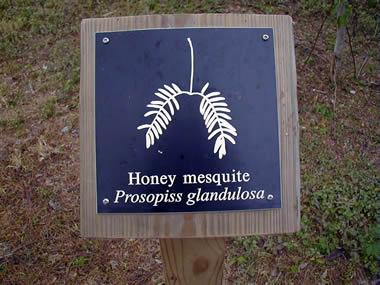| CompPanels: Images from the Annals of Composition #16 Docents Labeling |
What's in a label? Not much, you would think. But rhetorically a lot can be going on in the small confines that museum, park, or preserve docents are given to provide instruction for the public. Naming, for instance, takes place at the bottom of the label, center aligned, much like a tombstone inscription—suggesting that nothing more can be added. Plenty more can always be added, of course, hence the need to suggest the opposite. As for the sign's false information (the primary sin of docents), one misspelling is pretty minor in the history of this plant's naming. Consider just the names on this sign. It's misleading to suggest that the "honey" mesquite is all sweetness. True, mesquite flowers have a gland that produces nectar collected by bees (hence glandulosa), and the sap tastes sweet and can be chewed like candy. But when cattle eat too many of the tree's beans, as they are wont to do in times when forage is scarce, they tend to die. "Mesquite" itself comes from the Nahuatl word mizquitl, which refers to a different species. The genus term, "Prosopis," is the Greek word for burdock, not even a tree. It seems such misidentifications are the norm in the history of plant nomenclature. When the Spanish conquistadors first laid eyes on the New World mesquite, it reminded them of the Old World carob tree, so they called it algaroba. As well it ought, the rhetoric of instructional labeling has been studied. Check out P. M. McManus, "Oh, yes they do: How museum visitors read labels and interact with exhibit texts," Curator 32.3 (1989), 174-189; Beverly Serrell, Exhibit labels: An interpretive approach, Walnut Creek, CA: Alta Mira Press (1996); or the authors in Andrée Blais (Ed.), Text in the exhibition medium, Québec: Société des musées québécois; Musées de la civilisation (1995). RH, January 2004 |
 Label
on a path in the Pat and Hans Suter Wildlife Refuge, Corpus Christi,
Texas. The tree it identifies, with the genus misspelled, is a species
of mesquite very common in Texas, Prosopis glandulosa Torrey.
Label
on a path in the Pat and Hans Suter Wildlife Refuge, Corpus Christi,
Texas. The tree it identifies, with the genus misspelled, is a species
of mesquite very common in Texas, Prosopis glandulosa Torrey.